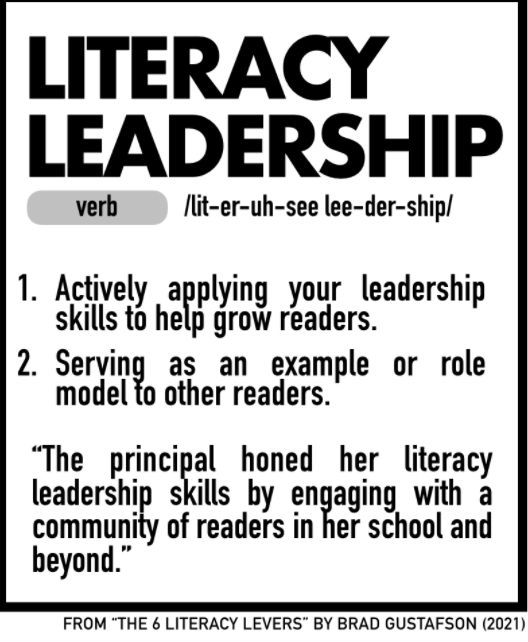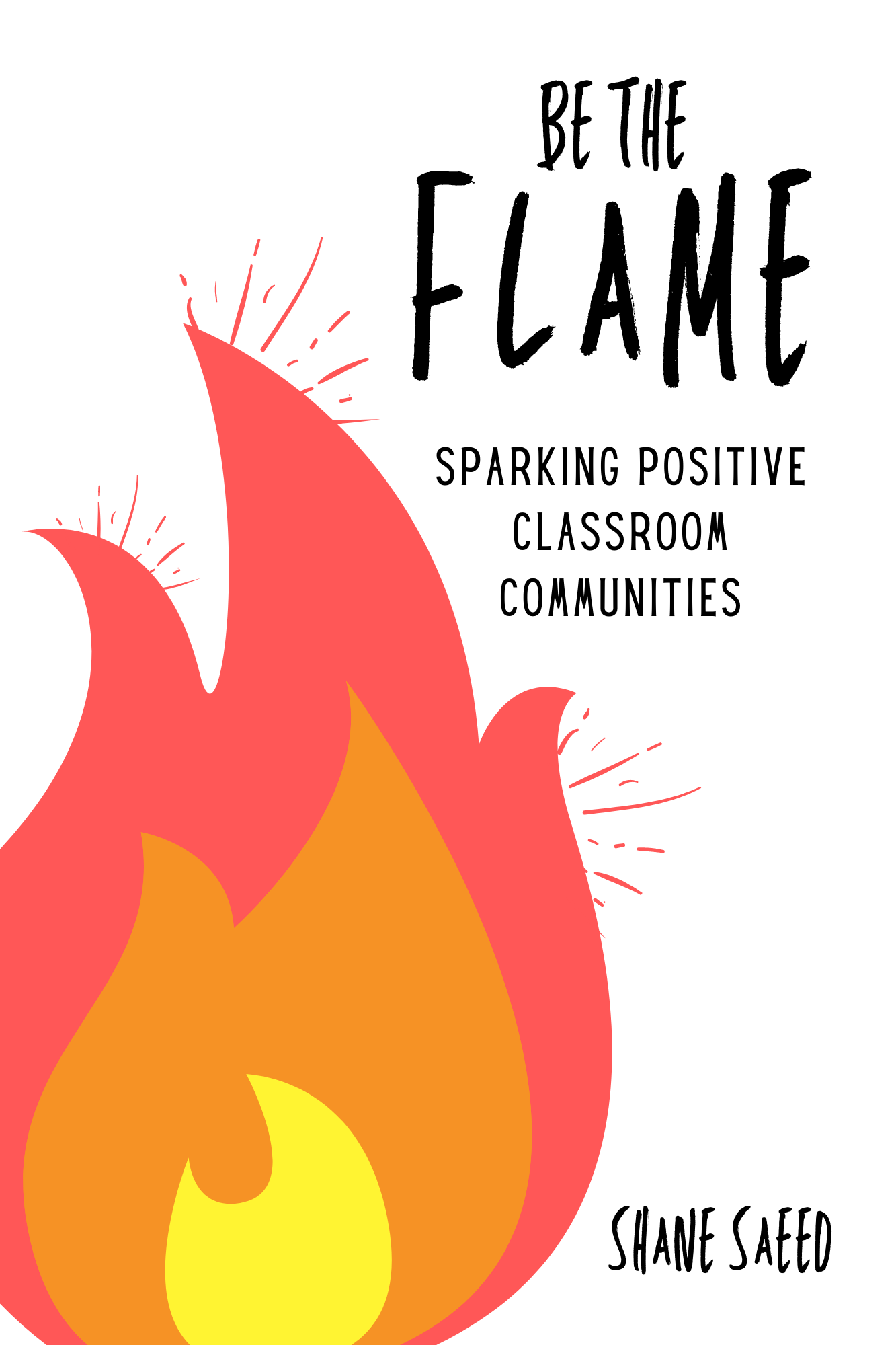CONNECTIONS: Activate Your Literacy Leadership
The following blog post is from Dr. Brad Gustafson, author of our latest book, The 6 Literacy Levers: Creating a Community of Readers (see below for more info about Brad’s new book):
”Every student deserves a literacy-rich environment in which reading is championed
by the leaders in their school.”
My wife and I recently visited friends we haven’t seen since the pandemic started. Over the past couple of years, their family has doubled in size--they recently welcomed two beautiful babies into their family. Twins. Needless to say, our time together was filled with lots of laughs, stories, and baby talk. At one point we were talking about all the cool baby gear on the market. I remember shaking my head and wondering how my buddy was managing everything. He looked at me and said something to the effect of, “One of our main priorities has been investing in things that help everyone sleep.”
The implication was that most of the baby gear and gadgets on the market look cute, cool, or helpful. However, without sleep everything tends to unravel. And this made me think of the countless decisions educators are tasked with making.
There are many things--many good things--on our radars right now. This much is obvious. But if teaching kids how to read--and creating the conditions where they want to read--isn’t considered one of the main things, we’re missing the mark. Literacy leaders understand that successful readers have the capacity to be more successful in nearly every other academic endeavor (Gustafson, 2021; Irvin, 2010). We must co-create the conditions that ensure reading transcends language arts.
To that end, the work we do to create a community of readers isn’t something that should be relegated to the select-few leaders in your school who have “reading” or “literacy” in their titles and job descriptions. Literacy leadership is something readers need from all of us. Because it will take all of us to ensure all of them leave school with the reading skills, dispositions, and experiences they deserve.
My new book, The 6 Literacy Levers will help you and your school invest in six things that matter most to readers, specifically, six levers that will help you and your colleagues create a community of readers. The book goes well beyond sharing what matters. It delves into why they matter and how to make them happen, regardless of the position you’re serving in right now.
The book contains a vast collection of actionable tools and examples readers can put to use. You’ll find ideas you can implement immediately in your classroom and/or school leadership position. You’ll also find activities to push conversations and work forward as a team, including a series of school-wide implementation challenges at the end of each chapter.
Whether you read this book with the goal of enhancing your own leadership or to strengthen your school’s reading community, the goal is to help you create the conditions in which readers feel more seen, supported, and successful in literacy and throughout the rest of their lives.
Resources:
Gustafson, Brad (2021). The 6 literacy levers: Creating a community of readers. ConnectEDD Publishing.
Irvin, J. L. (2010). Taking the lead on adolescent literacy: Action steps for schoolwide success. Corwin Press.
Creating cultures in which literacy is always on the radar of all educators within the school is another way we create a positive and productive culture in our schools. Thanks to Brad for this post and, more importantly, for his powerful new book which we are honored to publish. See below for more information about this new book.
Thanks to all educators reading this for the amazing work you are doing during these challenging times. Happy Holidays and, as always, Teach and Lead with Passion...
Jeff and Jimmy
DAILY INSPIRATION EDUCATOR
(Please let us know about an inspiring educator you think we should highlight in a future newsletter by completing this brief form!)
NEW BOOK!!
The 6 Literacy Levers: Creating a Community of Readers by Brad Gustafson (Twitter: @GustafsonBrad)
The 6 Literacy Levers is a game changer! We cannot wait for you to read this book by one of our favorite educators and servant leaders, Dr. Brad Gustafson. If you are a leader in any capacity with a desire to promote reading and literacy in your classroom, school, or district, this book is for you! The 6 Literacy Levers is designed to empower leaders in classrooms, libraries, offices, and every space in between. It includes ideas and strategies to support educators at every level because leadership isn’t reserved solely for those who hold a specific job title. There isn’t a single reader in your school who doesn’t deserve to be seen, supported, and included. This book includes levers and cautionary advice to help you respond to practices that could damage, diminish, or exclude any of the readers you serve. Literacy leaders have a responsibility to serve on behalf of all readers and this book will help you do just that.
This book is for any educator who wants to grow as a literacy leader.
This book will empower teams to initiate conversations that will take the work deeper.
This book explores six literacy levers that will help you push the field forward while creating more enriching reading experiences for the readers you serve.
This book will equip you with actionable ideas and the research needed to activate change.
Filled with inspiring stories and practical advice and strategies, The 6 Literacy Levers is
a book that will transform the literacy culture wherever you serve. We are so honored to
partner with Brad on this important new book. This book is now available on Amazon and on our website. Learn more here and contact us for bulk order discounts!
FEATURED BOOK
Be the Flame: Sparking Positive Classroom Communities by Shane Saeed
Educators know that relationships and rapport are the most important foundational pieces to a successful classroom community. The hard part is knowing how to build those impactful relationships. How do you establish and maintain rapport? What activities can encourage teamwork? How do you continue to build community throughout the school year? In Be the Flame, teacher leader Shane Saeed details ideas and activities that spark positive classroom communities and create learning environments in which students can thrive. Be the Flame focuses on building communities in different areas of an educator’s professional realm:
Kindling rapport with students one-on-one,
Igniting a community among your students,
Catching support from the families of your students,
Fueling relationships with teammates and coworkers, and
Establishing an online community to spread ideas, learn, and grow.
In this book, you’ll learn how to become a “teacher flame” through community-building practices that can be implemented the very next day. From step-by-step directions for relationship building activities to easy-to-implement routines to encourage community and strengthen partnerships, this book is an elementary teacher’s guide to starting their classroom community from the first day of school. Teachers will learn not only how to build relationships with their students, but also with families and coworkers in order to cultivate a cohesive community of support. It takes a village to support students and create a safe space for them to learn and grow. It is our job, as educators, to build strong foundational relationships with students that will inspire them to achieve academically and become the best people they can be. Be the Flame in your classroom and spread your light to impact your students in a positive way!
See what everyone is talking about by checking out Shane’s new book: Learn more here and contact us for bulk order discounts!
CONNECTEDD’S TAKEAWAYS:
Thought for the Day: “Stop giving kids the turn by turn directions...give them the destination and guide them on their own route.” via @ktvee
Teaching Technique to Try: Life Road Maps. In The Life Road Maps strategy students draw a map of someone’s life that highlights the important events and decisions that shaped that person’s identity. This activity helps students better understand historical or literary figures by focusing their attention on the many factors that contributed to a figure’s decision making. You can use this strategy as part of a research project, as a way to review previously studied material, or as an assessment tool. You can also have students create personal “life road maps” to help them reflect on key choices that have shaped their own identities.This also makes for a useful community-building activity at the beginning of a Facing History class or unit. Use it at the beginning of an identity unit or at the beginning of a course to help create a safe environment in which students feel comfortable sharing and listening to one another.Check out this link from Facing History and Ourselves for a step-by-step process for using this technique.
Eyes On Culture: We believe that culture is a true difference maker in any classroom, school, district, or organization. As a result, we focus much of the work we do on creating and maintaining positive and productive cultures. Culture Focus: Carry the Banner. High performing schools with strong cultures are places in which stakeholders regularly “Carry the Banner” as described by Jimmy Casas in his book Culturize. What does it mean to “Carry the Banner?” It means that we intentionally speak about our school, our students, our staff, our district,and our school community with pride and positivity. Just like schools everywhere, schools in which students, staff, and parents carry the banner for each other, there are always challenges and disappointments. Yet, unlike in some schools where stakeholders fall into the tempting trap of complaining and talking negatively about the school, the students, and each other, educators in these schools constantly shine a light on all the positive attributes of their school. They brag about the kids, their colleagues, and the accomplishments they have achieved. The more people serving in the school “carry the banner,” the more we find that: 1. This becomes contagious. Others start carrying the banner for those of use working in the school. Rather than complain about their school, students and parents start bragging about the school and its staff; 2. This becomes a self-fulfilling prophecy. The more we point out the positive, the more obvious all the good things about the school become; 3. This becomes part of the culture. Not only does speaking positively become “the way we do things around here,” speaking negatively eventually becomes uncomfortable to the point that it rarely happens. We must underestimate the powerful impact that speaking positively about our organization can have not only on the culture, but also on the people teaching, leading, and learning in that culture.
What are some ways we can “Carry the Banner” in our schools? Please share your thoughts about culture and hope via Twitter: @ConnectEDDBooks We would love to hear from you!



